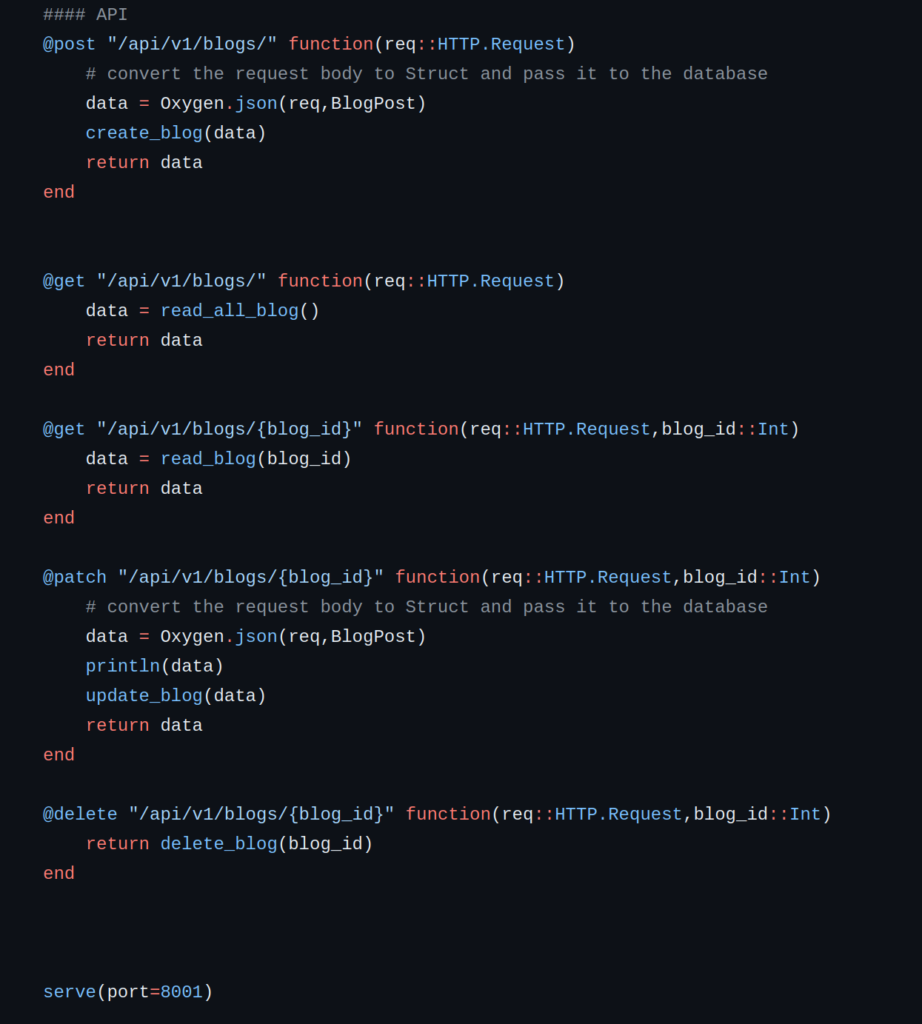CRUD – Create, Read , Update and Delete is an important concept to master and know for building most applications. In this tutorial we will explore how to build a simple CRUD API in Julia using the Oxygen Framework – which is like the Flask equivalent in Julia.
Oxygen.jl is a Julia package for building web apps with a simple syntax. Unlike Genie Framework, oxygen uses a similar api like Flask to make it easy to build web apps. Let us see how to build our CRUD API.
Our CRUD API consist of the following
- Struct: used for our model structure and schema
- HTTP methods coming from Oxygen.jl
- SQLite: used to handle our database and data storage
Since we do not yet a simple ORM to manage our data in Julia we will use SQL to handle the storage and management of our data.
Installation and Setup
We will first activate a julia environment in order to track the packages we will be using and then install the following packages such as Oxygen.jl, StructTypes , SQLite, HTTP.
]activate . > add Oxygen HTTP SQLite StructTypes
Basic App
Let us build a basic app(app.jl) using Oxygen.jl and then update it according with the various parts i.e. database, crud endpoints,etc.
using Oxygen
using HTTP
@get "/" function(req::HTTP.Request)
return "Hello Julia Web App"
end
serve(port=8001)
To run the app you can use
julia --project app.jl
Setting Up the Database
We will be using Structs to model our schema and use it as a guide to structure our data and its serialization.
using SQLite
db_path = "blog.db"
db = SQLite.DB(db_path)
SQLite.execute(db, "CREATE TABLE IF NOT EXISTS blogpost(id INTEGER PRIMARY KEY,title TEXT NOT NULL,content TEXT NOT NULL)")
struct BlogPost
id::Int
title::String
content::String
end
# Add a supporting struct type definition so JSON3 can serialize & deserialize automatically
StructTypes.StructType(::Type{BlogPost}) = StructTypes.Struct()
function create_blog(blogpost::BlogPost)
DBInterface.execute(db, "INSERT INTO blogpost (title, content) VALUES (?, ?)", (blogpost.title, blogpost.content))
return
end
Storing and Handling Data
In order to store the data being added to the application, we will use SQLite, you can also use postgres or other packages. It is always advisable to create functions to simply task, hence we will create our functions for our CRUD equivalent SQL statements.
function create_blog(blogpost::BlogPost)
DBInterface.execute(db, "INSERT INTO blogpost (title, content) VALUES (?, ?)", (blogpost.title, blogpost.content))
return
end
function read_blog(id::Int)
result = DBInterface.execute(db, "SELECT * FROM blogpost WHERE id = ?", (id,))
if !isempty(result)
row = first(result)
return BlogPost(row[1], row[2], row[3])
else
return nothing
end
end
function read_all_blog()
result = DBInterface.execute(db, "SELECT * FROM blogpost")
return [BlogPost(row[1], row[2], row[3]) for row in result]
end
function update_blog(blogpost::BlogPost)
DBInterface.execute(db, "UPDATE blogpost SET title = ?, content = ? WHERE id = ?", (blogpost.title, blogpost.content, blogpost.id))
end
function update_blog_by(blog_id::Int64,blogpost::BlogPost)
DBInterface.execute(db, "UPDATE blogpost SET title = ?, content = ? WHERE id = ?", (blogpost.title, blogpost.content, blog_id))
end
function delete_blog(id::Int)
DBInterface.execute(db, "DELETE FROM blogpost WHERE id = ?", (id,))
return nothing
end
CRUD API endpoints
For our CRUD API points we will use Oxygen.jl to create our endpoints that maps to our HTTP methods respectively.
@post "/api/v1/blogs/" function(req::HTTP.Request)
# convert the request body to Struct and pass it to the database
data = Oxygen.json(req,BlogPost)
create_blog(data)
return data
end
@get "/api/v1/blogs/" function(req::HTTP.Request)
data = read_all_blog()
return data
end
@get "/api/v1/blogs/{blog_id}" function(req::HTTP.Request,blog_id::Int)
data = read_blog(blog_id)
return data
end
@patch "/api/v1/blogs/{blog_id}" function(req::HTTP.Request,blog_id::Int)
# convert the request body to Struct and pass it to the database
data = Oxygen.json(req,BlogPost)
update_blog(data)
return data
end
@delete "/api/v1/blogs/{blog_id}" function(req::HTTP.Request,blog_id::Int)
return delete_blog(blog_id)
end

We have seen how to build a simple CRUD API using Oxgyen Framework in Julia, you can also check out the video tutorial below
Thank you for your attention
Jesus Saves
By Jesse E.Agbe(JCharis)
The code did not run well. Adding my first item goes well:
{
“id”: 1,
“title”: “First Blog”,
“content”: “My first blog item”
}
But after using 127.0.0.1:8001/api/v1/blogs, I get the error: “message”: “The Server encountered a problem”. I also bought your Udemy course, the same problem. I am using julia version 1.8.2. Any suggestions?
Hello Rob, pls could you omit the id and check if it works. Hope this helps